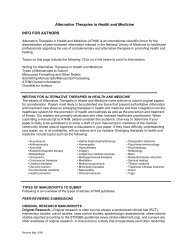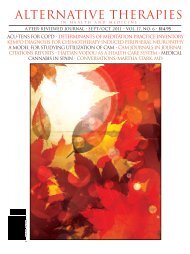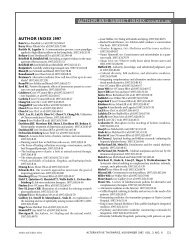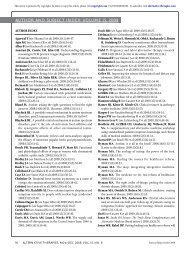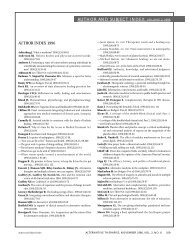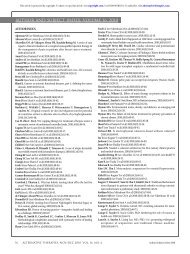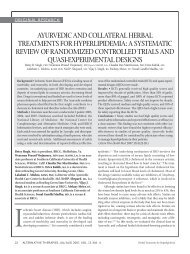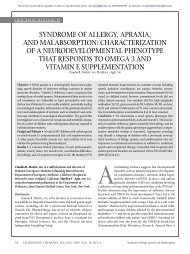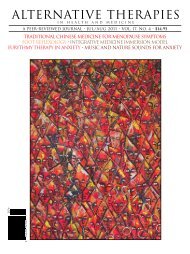Alternative Therapies In Health And Medicine
Alternative Therapies In Health And Medicine
Alternative Therapies In Health And Medicine
Create successful ePaper yourself
Turn your PDF publications into a flip-book with our unique Google optimized e-Paper software.
Tuber Ophiopogonis Japonici 2.75%; Concha Margaritifera 8.25%; and<br />
honey 5.76%. This CHM had been produced by Beijing Tong Ren<br />
Tang Company as brown honey-pills with a sweet, mildly bitter taste.<br />
All herbs were administered within standard dosage levels and were<br />
screened for heavy metals. The dosage of the formula was based on<br />
the Pharmacopoeia of the People’s Republic of China 2005 23 and previous<br />
animal experiments. Each dose of CHM was packaged in identical foil<br />
sachets. Patients in the CHM group were instructed to ingest one<br />
sachet of KBW pills with warm water twice a day after a meal.<br />
Patients in the ACU + CHM group received 10 sessions of acupuncture<br />
using kidney tonifying protocol as well as 5 g (one sachet) of<br />
KBW twice a day. <strong>In</strong> every session of acupuncture therapy, needles<br />
were retained for 20 minutes without any additional manipulation,<br />
moxibustion, or cupping. The same acupoints were used in all patients,<br />
including UB23, UB15, KD3, SP6, LV3, LU7, KD6, CV4, HT6, KD7,<br />
and LI4. Those acupoints were selected according to traditional indication<br />
for the treatment of the pattern of kidney and liver yin deficiency<br />
accompanied by liver yang hyperactivity, which was the chosen<br />
Chinese medicine pattern as an inclusion criterion in this research.<br />
The HT group was offered two different regimens during the<br />
2-month study period depending on the patient’s willingness for<br />
menses: steady conjugated estrogen 0.625 mg per day plus medroxyprogesterone<br />
acetate 2 mg per day or conjugated estrogen 0.625 mg<br />
per day for 28 days plus medroxy progestrone acetate 4 mg per day<br />
in the last 12 days repeated after 7 days of rest.<br />
Detection <strong>In</strong>dex and Method<br />
The favorable sample size was estimated at 60 participants<br />
based on the results of previous studies 21,23 with the level of confidence<br />
at 95% and power at 80%. The actual sample size was<br />
increased by 20% compared to the proposed sample size (n = 72) in<br />
anticipation of probable dropouts. The clinical menopausal symptoms<br />
were assessed employing the Kupperman index scale. The<br />
primary outcome was the mean difference in Kupperman score<br />
between baseline and 2 months. The secondary outcome measures<br />
were the mean difference in FSH, E2, and number of symptoms<br />
between baseline and 2 months. The method for measuring the<br />
level of FSH and E2 was chemiluminesence immunoassay. All<br />
reagents were provided by Siemens <strong>Health</strong> Care Diagnostics Ltd,<br />
Shanghai, China. <strong>In</strong> perimenopausal women with variable cycles,<br />
the levels of FSH and E2 were drawn on the third cycle day.<br />
The Kupperman <strong>In</strong>dex was used to assess the symptoms. The<br />
Kupperman <strong>In</strong>dex and the modified Kupperman <strong>In</strong>dex have been<br />
adopted by most of the researchers on menopausal symptoms in<br />
China. According to the study by Xu et al, 24 the modified Kupperman<br />
<strong>In</strong>dex is the most appropriate to use in research on the effects of<br />
Chinese medicine on menopausal symptoms because it perfectly<br />
corresponds to the detailed symptoms derived from the theory of<br />
Chinese medicine. The Kupperman <strong>In</strong>dex used in this study was very<br />
similar to the modified version, except it assesses one more symptom,<br />
paresthesia.<br />
Data Analysis<br />
Results were analyzed with the Statistical Package for Social<br />
Sciences (SPSS 11.5 for Windows; SPSS <strong>In</strong>c, Chicago, Illinois) by an<br />
independent university statistician who was blind to the study<br />
groups. A Kolmogorov-Smirnov test demonstrated that Kupperman<br />
index, FSH, E2, number of symptoms before and after the treatment,<br />
and differences were normal in all three groups. Therefore,<br />
t-test and analysis of variance (ANOVA) were found valid. Data were<br />
analyzed with ANOVA, paired and independent sample t-test, chisquare<br />
test, and Tukey’s Honestly Significant Difference (HSD) test.<br />
Significance level stood at .05.<br />
RESULTS<br />
The participants were between 40 and 59 years of age with an<br />
average age of 48.87 ± 3.71 years. There was no significant difference<br />
in the background characteristics of patients among the three<br />
groups (Table 1).<br />
Comparison of Kupperman Score Among Groups<br />
All three groups showed a significant reduction in symptoms<br />
from the pretreatment to posttreatment stage according to<br />
paired t-test results (P < .001; Table 2). Mean and standard devia-<br />
Item<br />
TABLE 1 Participants’ Background Characteristics<br />
KBW<br />
(n = 22)<br />
ACU + KBW<br />
(n = 20)<br />
HT<br />
(n = 15) Significance<br />
Demographic Characteristics<br />
Age 49.36 ± 4.07 49.65 ± 2.97 47.13 ± 3.70 P = .09 (ANOVA one-way test)<br />
Married 21 20 15<br />
Single 1 0 0<br />
P = .46 (chi-square test)<br />
Educational Background<br />
High school diploma and less 4 3 1<br />
College and more 18 17 14<br />
P = .60 (chi-square test)<br />
Stage of Menopause<br />
Perimenopause 16 13 11<br />
Postmenopause 6 7 4<br />
P = .82 (chi-square test)<br />
Abbreviations: KBW, Kun Bao Wan; ACU, acupuncture; HT, hormone therapy.<br />
50 ALTERNATIVE THERAPIES, jul/aug 2011, VOL. 17, NO. 4<br />
Menopause: Traditional Chinese <strong>Medicine</strong> vs Hormone Therapy



